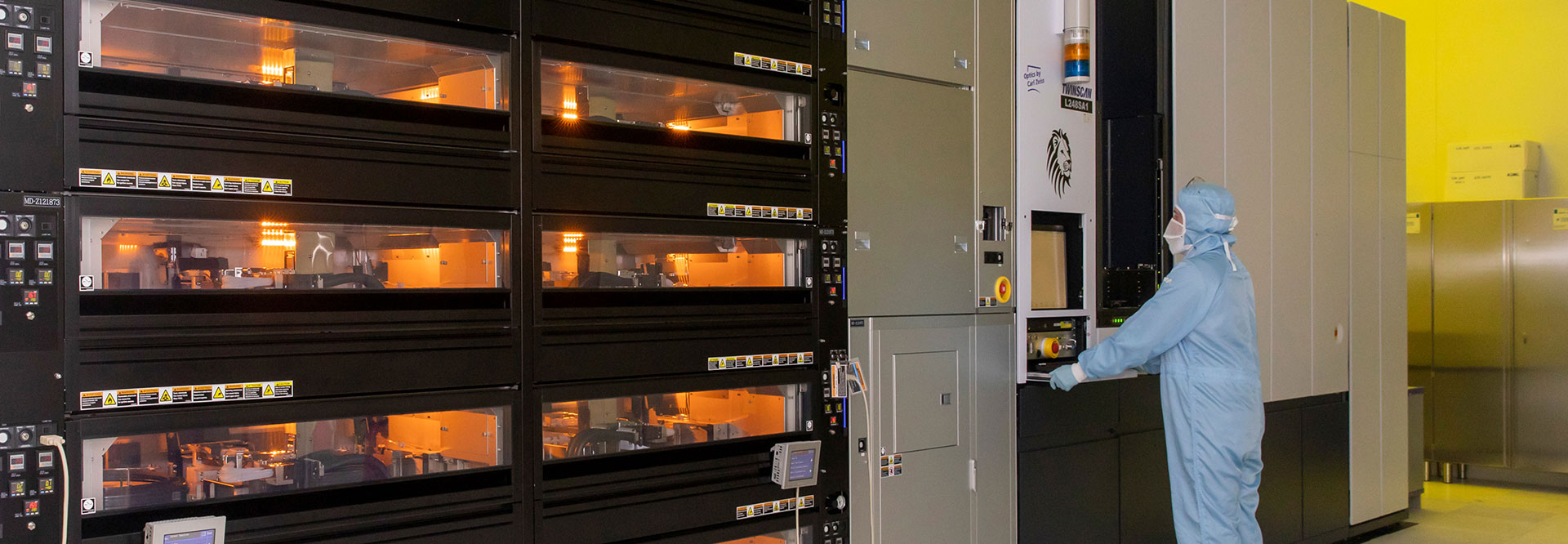Chemicals
It is our priority to responsibly manage chemicals and replace hazardous substances wherever possible.
700+
new risk assessments conducted
100%
PFOA-free across our sites
18,000+
people trained on chemicals
We carefully manage the chemical substances and materials we use throughout our operations. This allows us to monitor and address our impacts on people and the environment and to comply with legal and customer requirements.
Applying a rigorous approach
Our use and handling of chemicals is led by a precautionary approach, as set out in Principle 15 of the Rio Declaration and in the ST sustainability charter, available at www.st.com/sustainabilitycharter. I 2-23 I
At each of our manufacturing sites, a chemical committee meets regularly to review and evaluate best management practices for identified hazards. Modifications to existing processes are also considered and implemented where necessary. The committee uses a comprehensive approach to make decisions on chemical usage. This includes evaluating chemical compositions, hazards, use conditions, engineering controls, medical recommendations, and industrial hygiene requirements. Risk management measures, personal protective equipment (PPE), waste management, administrative controls, and training requirements are also considered. By rigorously applying this process, we can identify critical substances as soon as they are introduced or reclassified.
700+
new risk assessments
We recorded 4,310 chemicals in use in 2022 and we conducted more than 700 new risk assessments, achieving over 23,000 validated risk assessments by the end of the year.
To minimize potential environmental, health and safety (EHS) risks, both to our workers and the environment, we have stringent guidelines for identifying and assessing major risks. We use a four-step risk assessment process that incorporates two complementary methodologies. It is the site manager’s responsibility to ensure these risk assessments are conducted and any residual risk is minimized.
Since early 2000, we have applied the hierarchy of controls approach to our chemical management procedures. When specific chemicals or materials cannot be eliminated or substituted with less hazardous alternatives, we implement engineering measures and administrative controls to reduce workers’ and environmental exposure. I 3-3 I
Hierarchy of Controls
Safety of our people
Our goal is to prevent occupational injury and illnesses for all our workers. The health of all employees working with chemical substances is monitored through medical surveillance. This includes biomonitoring – a process to assess an individual’s exposure to natural and synthetic chemicals based on analysis of human tissue and fluid samples. As an additional precaution, we regularly analyze the air in work areas to verify that our risk management measures are effective. The results are compared to applicable threshold limit values (TLV). In 2022, over 11,000 measurements were performed, all but eight of these measurements were below the applicable TLVs. Further investigation showed the eight measurements that failed were the result of insufficient ventilation, which has now been corrected.
18,000+
hours of training on chemicals
All workers receive specialist training before being assigned potentially hazardous tasks or implementing process changes. At present, this includes instruction and preparation to:
- identify specific hazards
- recognize and understand chemical labels
- apply management methods
- only use equipment in good condition
- select and wear the required PPE
- be ready to react in case of contamination, contact, or an emergency
- ensure preventive maintenance
- properly dispose of spent chemicals according to waste management practices
In 2022, we provided more than 18,000 hours of training on chemical substance management across our manufacturing sites.
Protecting the environment
Reducing environmental emissions across the domains of air, water, and waste is a priority. We treat our emissions (see Water, Waste), and where possible, enforce replacement programs for hazardous substances throughout our value chain.
Volatile organic compounds (VOC) are compounds that easily become gases or vapor, some of which may have adverse effects on human health and the environment. We pay specific attention to controlling VOC emissions and use online monitoring to make sure our installations are working effectively.
Substituting hazardous substances
We search for the best solutions using technology and innovation to replace hazardous materials in our manufacturing processes.
Removing perfluorooctanoic acid (PFOA) related substances
Following 10 years of continued efforts, we reached our objective of being 100% PFOA-free in 2022. This was 3 years ahead of our target, as defined by the World Semiconductor Council and European Union regulation. The phasing out of chemicals containing PFOA-related substances used in the photolithography process was completed in February at our Crolles site (France). An alternative product was qualified and introduced into manufacturing. This required adjustments in several processes to achieve the necessary component performance.
100%
PFOA-free
This meant that PFOA-related substances were totally eradicated across all our operations without any supply chain disruption, while improving process quality and equipment efficiency, and maintaining product performance.
Working together for alternatives to lead
We have been part of the Die Attach5 industry consortium since its inception in 2009. The consortium is composed of five semiconductor companies and works on identifying alternatives to lead-based solders. Over the last 14 years, more than 160 materials from 15 suppliers have been evaluated, with around 50 undergoing extensive testing. So far, no reliable lead-free technology has been found for power semiconductor components, but the research is promising for a long-term solution.
In July 2022, consortium members met at our Agrate site (Italy). They discussed the practicalities of manufacturing with the selected new materials, as well as the viability of the test results. The preliminary results identified several new materials suitable for the manufacturing of advanced devices.
Striving for better
In 2012, di (2- ethylhexyl) phthalate (DEHP) was added to REACH(2) Annex XIV preventing its use in Europe. We immediately started a program to replace it, which resulted in all European products being DEHP-free by 2013. Subsequently, we decided to go beyond the regulation and replace the substance across all products worldwide. At present, only our Muar site (Malaysia) is using DEHP in an ancillary material in the assembly process. A substitute solution and process have been proposed to customers and are in the final phase of qualification.

Giulia Mancini
Chemical Programs Senior Manager,
Corporate Sustainability
Managing chemicals is complex and requires a multi-faceted approach. We address emerging EHS regulations and anticipate future regulations while taking into consideration new customer demands. Any substance elimination or process changes must be carefully implemented to ensure manufacturing remains stable and quality is maintained. This involves continual communication with internal and external teams to find the best solutions. Ultimately these actions help us protect people, preserve the environment, and provide the highest standards for our customers."
Aligning with stakeholders’ expectations
Compliance
We follow the highest standards to ensure compliance with all applicable regulations on chemicals for our manufacturing sites and our products. It is the responsibility of each site to ensure compliance, based on their specific operations.
When developing new products, their compliance is verified at fixed product development milestones. At the R&D phase, we only consider and select compliant materials to ensure we act in accordance with requirements, such as RoHS(3) and ELV(4).
Furthermore, we strive to eliminate the use of restricted substances by design. Thanks to new designs, reduced dimensions and the lower energy consumption of our chips, we have had ongoing success in decreasing the use of lead in the assembly process (see our ECOPACK results). We also continue to identify new materials with reduced antimony and halogen content.
ST products may be subject to Substances of Concern In Products declarations, based on the presence of Substances of Very High Concern. In 2022, we continued to declare new products in the Europena Chemicals Agency portal to ensure information is available for safe end of life disposal.
Across our sites, we continue to work on hazardous substance process management to identify, control, quantify, and report any hazardous elements in components, according to the IECQ 080000 standard.
Customers
Chemical legislation is evolving globally to reduce environmental impacts during manufacturing. It remains a significant consideration for key customers who closely monitor developments in our products, processes and compliance. Information on materials contained in ST products can be found through the IPC 1752 material declaration which is available on www.st.com. Queries relating to chemical substance usage accounted for almost 20% of our EHS enquiries in 2022. Thanks to the measures we have in place, we are well positioned to address them. During the year, our Shenzhen site (China) successfully passed a remote customer audit related to substance management in components.
As a member of the Responsible Business Alliance (RBA), we are working to become aligned with the RBA Industry Focus Process Chemical policy (IFPC). All chemicals listed in the policy have already been eradicated from our own operations. In 2022, we completed an IFPC assessment to locate these chemicals within our supply chain. We are now working on measures to replace them, prioritizing recommendations by the Clean Electronic Program Network.
Suppliers
We require our suppliers to respect our EHS-regulated substances list, which contains more than 7,700 substances and is regularly reviewed. We also require them to confirm their compliance through analytical certificates, safety datasheets and commitments. In 2022, 95% of our key suppliers committed to our substances specification.
Contributing to the Sustainable Development Goals
Our commitments and programs as described above contribute to:
SDG target 3.9 – Substantially reduce the number of deaths and illnesses from hazardous chemicals and air, water and soil pollution and contamination.
SDG target 6.3 – Improve water quality by reducing pollution, eliminating dumping and minimizing release of hazardous chemicals and materials, halving the proportion of untreated wastewater and substantially increasing recycling and safe reuse globally.
SDG target 12.4 – Achieve the environmentally sound management of chemicals and all wastes throughout their lifecycle, in accordance with agreed international frameworks, and significantly reduce their release to air, water and soil in order to minimize their adverse impacts on human health and the environment.
2025 sustainability goal |
Status |
Comments |
In line with the WSC statement, remove PFOA and PFOA‑related substances in all manufacturing chemicals by 2025. |
100% |
Annual sustainability goal |
Status |
Comments |
SG19: Follow highest standards for 100% of the materials we use: Hazardous Substances Process Management (IECQ080000) and responsible sourcing initiatives, such as RMI. |
HSPM: 95% |
(2) REACH: Registration, Evaluation, Authorization and Restriction of Chemicals.
(3) RoHS: Restriction of Hazardous Substances.
(4) ELV: End of Life of Vehicles.


